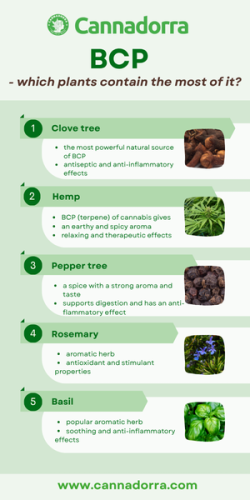🌿 Plants with the highest BCP content: A natural miracle for body and mind
Author: Lucie Garabasova
Beta-caryophyllene (BCP) is a unique terpene with proven anti-inflammatory, analgesic and relaxing effects. The special feature of BCP is that it is the only known terpene that binds directly to the cannabinoid receptor CB2 in the human body - and thus behaves similarly to cannabinoids from cannabis, but without psychoactive effects.
BCP is a natural component of the essential oils of many aromatic plants. Some of them contain it in very high concentrations. Which ones are they?
🥇 1. Clove (Syzygium aromaticum)
Clove is the absolute top among plants rich in BCP. Up to 80-90% of the essential oil is a mixture of eugenol and BCP, with beta-caryophyllene having a significant share. Clove is known for its analgesic effects and is used for toothaches, inflammation and for disinfection. BCP contributes significantly to its strength here.
🥈 2. Hemp (Cannabis sativa L.)
BCP is one of the main terpenes in many cannabis strains. It can make up 10-30% of the total terpene profile of the flowers. It is responsible for the spicy, peppery aroma of some CBD strains. BCP in cannabis acts synergistically with cannabinoids (CBD, CBG) and contributes to the so-called entourage effect - i.e. the enhancement of effects due to the presence of multiple active substances.
🥉 3. Black Pepper (Piper nigrum)
Black pepper essential oil contains 20-35% BCP. It is also rich in limonene, pinene and other terpenes. Pepper supports digestion, has antimicrobial effects and is traditionally used as a tonic. The aroma of black pepper is distinctively spicy, warm and earthy thanks to BCP.
4. Rosemary (Rosmarinus officinalis)
Rosemary is a popular Mediterranean herb with a typical aroma, which owes its sharpness to its BCP content. This can make up up to 12% of its essential oil. Rosemary has stimulating effects on blood circulation, supports memory and concentration. In aromatherapy, it is used for mental fatigue and muscle pain.
5. Basil (Ocimum spp.)
In some varieties of basil – especially Ocimum gratissimum or Thai basil – BCP is found in higher concentrations, approximately 8–15%. Basil is popular not only in cooking, but also in natural medicine for its relaxing and antibacterial effects. The aroma of basil can vary depending on the variety, precisely because of the different content of terpenes, including BCP.
6. Other plants containing BCP
- Oregano (Origanum vulgare) – in addition to carvacrol, it also contains a smaller amount of BCP, which contributes to its anti-inflammatory profile.
- Thyme (Thymus vulgaris) – the proportion of BCP is lower, but in combination with thymol and pinene it creates a strong antimicrobial spectrum.
- Chamomile (Matricaria chamomilla) – BCP occurs in smaller amounts, but thanks to the combination with bisabolol and chamazulene, it has a significant calming effect on the skin and nervous system.
Where can we definitely not find BCP?
BCP occurs naturally in a wide range of aromatic plants, but it is not ubiquitous. Below are groups of plants and foods where BCP either does not occur at all or only in negligible amounts:
❌ Citrus fruits (oranges, lemons, tangerines)
The main terpenes here are limonene, linalool and citronellal. BCP is absent here.
❌ Conifers (pines, firs, spruces)
Pinene and borneol are typical for them, but beta-caryophyllene is usually not found here.
❌ Fruits such as apples, pears, berries
Although they smell intensely, their terpene profile is completely different and BCP is not found in them.
❌ Vegetables such as carrots, broccoli, cauliflower, potatoes
They do not contain a significant amount of aromatic terpenes, and therefore BCP.
❌ Leafy vegetables (lettuce, spinach, arugula)
Low content of aromatic oils - BCP is not found in these plants.
❌ Coffee and tea
Although they contain many active ingredients (caffeine, tannins), BCP is not among them.
❌ Classic flowers such as roses, lilies, tulips
The aroma of these plants is based on compounds other than BCP.
✨ Why is BCP so special?
✅ Binds to the CB2 receptors of the endocannabinoid system
✅ Has anti-inflammatory, analgesic and antioxidant effects
✅ It is non-psychoactive and naturally occurs in foods
✅ Supports synergy with CBD and other cannabinoids
✅ Suitable for internal and external use (oils, ointments, aromatherapy)
💡 Final tip:
To naturally increase your BCP intake, use fresh or dried spices such as cloves, pepper and rosemary, or reach for CBD products with laboratory-confirmed terpene content. Look for labels such as “full-spectrum” or “terpene-enhanced”, which guarantee the presence of BCP and other bioactive components.


